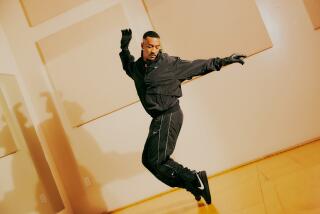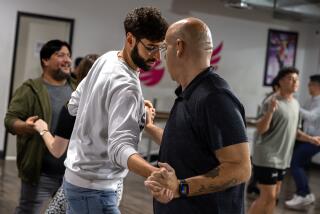‘He’s turning traditional dance on its head’: Why S.F., Houston and Seattle troupes are in L.A.
William Forsythe has a thing about rules. He likes to break them — or bend them. Maybe reinvent them?
The American choreographer, who performed with the Joffrey Ballet before serving as artistic director of Ballet Frankfurt and creating his own dance ensemble, the Forsythe Company, is as much a scholar of ballet as an innovator within the art form. He pairs classical and contemporary moves with hip-hop and electronic music in unexpected ways that are an ode to, and break from, tradition.
The Music Center will kick off its 2016-17 dance season on Friday with “Celebrate Forsythe,” part of a monthlong tribute. The program is unprecedented for the Music Center and for Forsythe: San Francisco Ballet, Houston Ballet and Pacific Northwest Ballet (in its Music Center debut) each will present a seminal Forsythe piece. The works will feature alumni of the Music Center’s arts training program for teens, Spotlight, and the organization is hoping the Forsythe program will draw a new and younger audience.
“He’s turning traditional dance on its head,” Music Center Chief Executive Rachel Moore said. “Which I think is appealing to a younger generation. This is not ‘Giselle’ or ‘Swan Lake.’ It’s very, very different.”
Forsythe recently talked with The Times for this edited conversation about his Music Center program as well as his work at USC.
What’s the significance of these three ballet companies coming together for “Celebrate Forsythe”? And how active have you been in working with them to prepare?
This is a precedent, I believe, that three companies will come together and present work by one choreographer. It seems like an interesting and exciting new model for [the Music Center]. You don’t have to travel, it’s all brought to you. Normally I bring in one company and they come with three pieces of repertory. One choreographer, three companies. It’s never been done before.
I’ve been very active. I went to Houston to stage and rehearse the piece. Then I flew up last week to San Francisco and rehearsed with them and made some revisions to the piece, as is normal. Now I’m on the road to Seattle to go rehearse.
The three pieces are from three periods of your career: “Artifact Suite” (1984), “The Vertiginous Thrill of Exactitude” (1996) and “Pas/Parts 2016.” Why did you choose these three works?
The pieces, themselves, represent a sort of retrospective and they’re also in the same class of choreography. They’re all in the same genre. They’re all neoclassical ballets — one quite early in the career, another one mid, and another one later.
As a retrospective, how do these works illustrate the evolution of your oeuvre?
You can see sort of a line of development where I was researching all these things and trying all these forms out. It’s interesting, I think, to see from ’84, “Artifacts,” and then to go to ’99, “Pas/Parts” [re-choreographed for 2016]. You see the logical trajectory of the work. It’s an extension of the technique. I’d say you could follow the rules.
For example, in “Artifact” there’s the beginning of a kind of gravitational extension in the pas de deux. But it’s still using classical ballet pretty strictly. There’s obviously a push toward modernization, though, especially in the staging: The curtain comes down several times in the middle of the first part, but that’s just a musical chapter being made. In “Vertiginous,” all of the moves are super traditional. But the speed at which they’re grouped is very unusual. It’s a sort of commentary. All of my ballets are commentaries on ballets. “Pas/Parts,” that’s more contaminated by other influences. There’s a tiny bit of hip-hop-inflected movement in some cases. But again, it’s still rooted in ballet. These are all ballets.
If all of your ballets are commentaries on ballet, what are you attempting to say about the form?
These are dances speaking only of dance. As soon as you bring ballet, you’re talking about history. There’s no way around it. It’s not like I’ve developed my own specific language and it has nothing to do with ballet, it looks very different, etc. etc. This is ballet. As soon as you do one ballet step, you’re putting yourself in a historical stream. And that becomes historically discursive. You’re part of the longer conversation.
Every piece you make, you have to make it for someone who has never seen a ballet before, for someone who’s gone to the ballet every day of their life, a fellow colleague, an expert, someone who actually doesn’t like your work. It’s always a discussion. In this case, you put this out and you wait for a response. And either it has resonance or it doesn’t.
Tell us about the music in the program. It’s an interesting mix. Do you think it will appeal especially to young people?
“Vertinginous” is Schubert. There’s an [electronic] score from Thom Willems. The other one is live piano. I don’t know that the music will bring in younger people. I think they’ll enjoy all three parts. As long as the dance and the music are functioning well together, if it actually functions well, as one would hope it would, then I think every part will be enjoyable. If a person says, “Oh, young people only like contemporary things …” Really? I don’t think so.
You’ve recently put roots down in L.A. as professor of dance at the Choreographic Institute at the USC Glorya Kaufman School of Dance. What do you think of the L.A. dance scene?
I’m so new to L.A., I’ve only just started to meet people in the scene. I can’t say yet. I’ve only seen one piece so far. I saw Wife [a performance art group consisting of Jasmine Albuquerque, Kristen Leahy and Nina McNeely] and that was incredible. It was completely surprising, an extraordinarily well made work. I thought, “Wow, if it’s anything like this, then wow.”
------------
Glorya Kaufman Presents Dance at the Music Center: ‘Celebrate Forsythe’
Where: Dorothy Chandler Pavilion, 135 N. Grand Ave., L.A.
When: 7:30 p.m. Friday-Saturday, 2 p.m. Sunday
Tickets: $34 to $138
Information: (213) 972-0711, musiccenter.org/forsythe
Follow me on Twitter: @debvankin
ALSO
L.A.’s dance scene gears up for a breakout season
Los Angeles Ballet dances through its growing pains
An ode to an avant-garde Japanese dance legend, performed with body and soul
More to Read
The biggest entertainment stories
Get our big stories about Hollywood, film, television, music, arts, culture and more right in your inbox as soon as they publish.
You may occasionally receive promotional content from the Los Angeles Times.







